Formations seem to have become an integral part of army building in 40k these days. Whether that is a good or bad thing is for each individual to decide, today I thought I would take you through my thoughts on formations and how I feel they influence the vast universe of warhammer 40,000 these days.
Not a free transport in sight…….
Right off the bat, it is only fair to let you know dear reader, that I rarely use formations in 40k. This is not due to some particular stance on the use of formations, I just like the Combined Arms Detachment (CAD) and find it the easiest way to make up an army and what I have been used to for many years. The second issue is that even with my vast collection of models for some armies, I sometimes still struggle to have the basic requirements for many of the formations that I can field, so am limited in this respect too. The one exception to this is the Ravenwing Strike Force from the 7th edition Dark Angels codex. Being a big fan of Ravenwing (and bike) armies, I have utilised this formation a lot in recent months, even taking an all Ravenwing army to a tournament using the formation and having a measure of success with it in my games. I have also been using the new White Scars formations that were made available recently. This give a nice thematic way to run my White Scars army, in addition to giving some incredibly powerful bonuses.
So this is where these opinions and impressions come from, a player who generally doesn’t use formations, but has some experience both playing with them and against them in a competitive and casual environment.
Also, a note of nomenclature. I tend to use Formations and Detachments interchangeably when talking about them. I know that there are differences between the two, but to me, the comments on one could be equally applied to the other.
The Early Days of Formations
Force Organisation Chart
You could argue that one of the earliest instances of the use of formations in 40k was the introduction of the Force Organisation Chart in 3rd edition 40k (I certainly would argue this, and since this is my article, I can do what I want!).
Hasn’t changed much at all.
Prior to 3rd edition, armies were constructed using the percentage system. Your army would be composed of units/models based on the percentage of the points used, for example; 25% or more core units, up to 25% characters, etc.
When 40k was re-launched with 3rd edition in 1998, a new mechanic for army building was introduced- the Force Organisation Chart (now known as the Combined Arms Detachment or CAD). For the first time, units in an army were separated into 5 different types; HQ, Elites, Troops, Fast Attack and Heavy Support. Players constructed armies by selecting units from “slots” in the force organisation chart and calculating their points cost for the unit until the agreed upon points limit was reached. The only compulsory choices in your army were one HQ and two troops slots. This limit still applies today in the CAD.
The idea was to allow players to build themed forces, more representative of typical armies your fraction would be likely to field. Your army would consist of an HQ unit to lead the army and two units of core troops to provide the backbone of the army. Additional troops units could be used to bolster your force and more powerful units could be taken from the other slots, though in lesser numbers to represent their more limited availability.
Even back then, modifications to the Force Organisation Chart were already in place. Imperial Guard units could field special “platoons” to allow them to take multiple troops choices and only use one slot in the force organisation chart. The highly-regarded Codex Chaos Space Marines 3.5 allowed Iron Warriors players to gain an additional Heavy Support slot for the loss of a Fast Attack slot. Certain special characters or HQ units allowed certain units to “count as” troops, allowing you to field Terminators, Bikers or Nobz in higher numbers than the standard chart would allow. Some units, mostly command squads or their equivalents, would not use a slot on the chart when purchased in conjunction with an HQ unit. Supplement codices could create new or elite armies by changing the Unit Type of existing units in the game to allow you to field a Trukk boyz heavy Speed Freaks army or Aspect Warrior focused Biel-Tan army.
So much variety in such a small book.
The lack of percentage point requirements meant that even with adherence to the force organisation chart, players could still field elite-heavy forces or tank-heavy forces, as well as creating super-powered characters to chew through the enemy army. The term “troop tax” was used to describe the penalty of purchasing the cheapest two compulsory troops choices available to have access to the “better” choices in a codex. This sort of tactic was always going to occur with any type of army selection, it probably even occurs with percentage-based systems.
Some players will always try to take an army to breaking point and beyond with “min-max”-ing army lists to create incredibly competitive and tight forces. I am not saying this is a bad thing. Many players find equal enjoyment from building “fluffy”, thematic armies to scraping every last point out of a list for the most effective combinations. Both play styles are equally valid, it just depends on what you enjoy and what your community embraces.
I liked the introduction of the Force Organisation Chart. It created a very different way to build armies than was previously seen in 40k and fantasy and seems to suit 40k well at that stage and continues to be amongst the most popular way to build an army, even in 7th edition.
Come the Apocalypse
The introduction of Warhammer 40,000 Apocalypse was met by great excitement in the 40k community (at least, it was in mine). For the first time, players were provided with rules for fighting massive battles that had only been the subject of background stories in codices. It also introduced rules for Superheavy vehicles, massive war machines such as the Baneblade or Stompa that had not been seen outside the realm of Epic 40,000 before. These vehicles were presented in their own special rulebook, as the thought of using a Baneblade or other Superheavy vehicles in a game of regular 40k was absolutely preposterous………….
No need for a dining room table when you have this book on hand.
As an aside, the Baneblade was (and continues to be) an amazing piece of kit. It looks stunning on the field and creates a fine focal point for any Imperial Guard army. I was amazed when I saw the first photos and that GW was actually making a kit of this size and complexity in 40k. The number of superheavy kits has steadily increased and most of them are amazing. Still no plastic Thunderhawk though!
Not only were the battles and vehicles super-sized, the Apocalypse book was also super-sized, being much larger in dimension than any 40k book previously published. Also present in the Apocalypse book were new rules for using formations in 40k.
These were a new way of building armies for warhammer 40,000. Rather than taking what units you wanted in accordance with the Force Organisation Chart, you were given a list of units that had to be purchased and would pay a “fee” for using the formation. This would then give you access to new or unique special rules that would affect the units in the formation.
For example, one of the most iconic of fighting formations in the universe of 40k, the Space Marine Battle Company, had its own formation in the first Apocalypse book. The battle company consisted of a Captain, 0-1 Chaplain, a Command Sqaud, 6 ten-man Tactical Squads, 2 ten-man Assault Squads and 2 ten-man Devastator Squads. The formation cost an additional 200 pts, and you gained three additional Apocalypse strategic assets for taking the formations (an orbital bombardment and some reserves manipulations).
Many of these formations were intended for use in large-scale battles. Some had requirements for a large number of units, requiring all but the most avid of 40k collectors to need several players to combine forces to get the formation bonuses. Other formations were much smaller, requiring only 3+ units to gain the bonuses. These formations cost an additional 25-250 pts for the bonus.
White Dwarf also became a huge resource for accessing new formations. New rules for formations were frequently published in the pages of GW’s premier gaming magazine. These would sometimes be themed around certain historical battles from the storylines of 40k or focus on race-specific formations and rules.
When the second edition of Apocalypse was released in 2013, it signalled another change in the use of formations. The additional points costs of formations was removed. In order to get the bonus, all a player needed to do was field the requirements of the formation. Perhaps in order to simulate that these were formations for larger scale engagements, the unit requirements for many of the formations increased dramatically from those in 2nd edition Apocalypse. Where before, a formation may consist of a couple of Whirlwinds and a Landspeeder, it would now likely consist of 3-4 times the number of units to access new, more powerful rules.
For many years, Apocalypse was one of the few ways to access formations in 40k. That all changed with the release of 7th edition.
The Rise of Formations
Codex Formations
The seventh edition of the rules brought about a seismic shift in the use of formations in 40k. There may have been formations available before this, but I think that the release of 7th edition and the subsequent codices have brought these into the mainstream more than ever before. I think that having these formations in the codex, rather than in White Dwarf, Apocalypse or Forgeworld, somehow legitimises them more, somehow.
The Combined Arms Detachment was included in the 7th edition rulebook and still proves to be a very popular Detachment/Formation. It uses the Force Organisation Chart of old and includes the bonuses of getting a re-roll on your Warlord Trait and gives your troops Objective Secured.
The re-roll is nice, allowing you the option not to be stuck with a useless Warlord Trait, but the real bonus is Objective Secured. This is an extremely beneficial special rule and has won me several games in the past when my opponent lacked the rule.
The first 7th edition codex to feature new formations was Codex Orks released in June 2014. The “Ork Warband” consisted of:
- Warboss
- Big Mek
- A unit of Nobz or Meganobz
- 6 Units of Boyz
- 1 Unit of Gretchin
There were no restrictions on the warband, so you could have trukk mounted units to emulate a speed freaks army (with the exception of the Gretchin, but proper Orks don’t care about Gretchin anyway) or could run large mobs on foot to overwhelm the enemy. The benefits for the formation included the ubiquitous warlord trait re-rolls, gaining Hammer of Wrath for the mobs when you rolled a certain value for your charge distance and allowing the Warboss to call a Waaagh! each turn.
Nothing too overpowered here. Just a nice way to field an Ork warband that encouraged players to take many units of Boyz, along with some Nobz to keep the boyz in line and some gretchin for the boyz to kick around. The formation gave Ork players some nice bonus special rules that were not too powerful and required unique conditions for the rules to activate (rolling a 10 or more on your charge distance).
The codex also included a new Detachment, giving the player access to additional HQ and Troops slots on top of the standard CAD. The Detachment gave the warlord trait re-roll and some Hammer of Wrath bonuses for certain units if they roll high enough for the charge.
The subsequent codices released provided some new formations for players, giving new special rules and abilities for specific army builds. These rules were not particularly overpowered, but did provide some nice special rules for units and formations.
Then the 7th edition Necron codex was released.
Overpowered Nonsense?
The mere mention of the Necron Decurion is enough to send a shiver down the spine of the most seasoned 40k players.
The introduction of the Necron Decurion represented another significant development in the use of formations in 40k. The Decurion was a new breed of army building; a formation of formations, if you will. Players were now able to build a detachment out of a mix of Core formations, Command formations and Auxiliary formations. Not only do you gain the benefits of the individual formations, but you also gain Detachment wide benefits, some of which are considerable.
Being the first of its kind, the Necron Decurion is a particularly powerful example. It’s major benefit is gaining +1 to Re-animation Protocol saves for the units in the Detachment, though it does still give other great benefits. This makes a Necron army nigh-on indestructible in many cases. This comes at a price though; the loss of Objective Secured. In my opinion, this is one of the few things that makes the Decurion beatable.
I have come up against the Decurion three times in a tournament setting (all three games against my White Scars). Of the three games, I have won two of them- both of which were objective-based games (one maelstrom and one end of game objectives) and Objective Secured was a key factor in each victory. The third game was a Kill Points mission and I was absolutely slaughtered.
In all three games, my White Scars army was decimated. In the first game, I had 6 models left, in the second game, I had 7 models left and in the third game, a solitary Rhino saved me from being tabled. In all three games, I had lost close to 90% of my models, if not more. In all three games, I would be surprised if I had killed more than one third of the opposing army.
In the two games that I won, I had to focus on achieving the objectives and ignore trying to kill the opposing army, as it proved impossible most of the time. In the kill points game, a combination of formation special rules and a resurrection orb meant that, to kill a unit of 6 wraiths, I would need to do a calculated 218 wounds on the unit to wipe them out. I wish I had done this calculation before the game as I would not have wasted most of my second turn trying to kill them (to very little effect).
I have spoken to several Necron players who no longer use the Decurion outside of tournament games. To them, using the Decurion is using Necrons in “easy mode” and victory is far too easy to come by in normal games.
I do not begrudge Necron players for using the Decurion. Most, if not all, players will choose to use the best rules available in many games. If I could use a Detachment that would boost the survivability of my army, I am sure that I would in many cases. The Decurion was just the first example of this type of Detachment and remains one of the most powerful.
The Decurion is not the only powerful one of its kind. The Eldar Warhost and Space Marine Gladius Stike Force also allows a player to build highly effective, highly competitive armies.
I am not too familiar with the Eldar Warhost, having only played it a few times, but I have come up against the formations allowing increased number of aspect warriors that boost their WS/BS and makes great Eldar units even better.
The Gladius has received a lot of attention from Space Marine players and a lot of criticism from non-marine players thanks to the free transports when using two battle demi-companies. Taking two battle demi-companies allows marine players to give free transports to all units that can take them in the two formations. This potentially gives the Gladius Strike Force an additional 660 “free” points in the army (twelve units can potentially take a Razorback as transport to make 660 pts of free transports).
The dual battle demi-company gladius appears to be quite popular in a tournament environment. The army gains the benefits of “free” points and all the units in the demi-company and their free transports have Objective Secured. This makes the Gladius an ideal Multiple Small Units (MSU) army for tournament games. The idea behind this army is that you have so much on the board that your opponent is simply unable to kill enough of your army in a standard 5-6 turn game that you can easily swamp the objectives at the end of the game or have a high number of mobile units for grabbing objectives in a maelstrom mission.
I have never actually faced this type of army before, so don’t know how difficult it can be first hand. My only guide is from what others have told me about it and what I have read online.
One of the problems with formations is that it can make already very strong armies (such as Space Marines, Eldar and Necrons) even more powerful with the addition of free special rules in the Detachments, whereas less powerful armies get some decent buffs that are nowhere near as powerful.
The Mechanicus War Convocation is a more recent example of a formation granting “free” points. This gives all units in the formation free upgrades to all weapons and wargear, which can be used to generate a lot of free points in the army.
I guess it all depends on the points of view. I, for one, would love to see a new Ork codex with a Decurion-style detachment that gave every unit Feel no Pain. I think that this would give Orks a real boost to their capabilities and help ensure the survival of big mobs to get to combat. No doubt, other non-Ork players may decry this as game breaking and overpowered.
In a more competitive setting, altering the missions being used can limit the usefulness of some of these formations. For example, the ITC missions use a mixture of kill points, maelstrom points and end of game objective scoring to determine victory points for the game. The dual battle demi-company army will probably do quite well when it comes to scoring objective maelstrom points and end of game objectives, but may suffer when it comes down to kill points, as I imagine most armies will be able to deal with Rhinos and Drop Pods with some ease.
The Ravenwing Strike Force Issue
The problem with some Formations and Detachments is when they have unclear rules that can be abused or having rules that players see as wrong.
One that was close to my heart was the issue with the Ravenwing Strike Force. As written on release, Sammael was the only HQ unit allowed in the Formation as he is the only HQ unit with access to the Ravenwing special rule, even though the Formation has three HQ slots.
The problem then arose from using different solutions to the apparent problem. For tournament play, this becomes important. The rules pack for the Rapid Fire 2015 tournament (that I attended) did not allow any other bike-mounted characters in the strike force, using the rules as written, whereas Blog Wars X (that I also attended) allowed other bike-mounted characters and replaced the Deathwing rule with the Ravenwing rule (as well as making Sammael a compulsory choice in the detachment). Both tournaments were equally valid in how they chose to deal with the Strike Force, but both could lead to different armies being fielded.
Another issue that caused problems was if Independent Characters could join the Skyhammer Annihilation Force and if they did so, how were they and the units affected. Some argued that the characters could not join the force as they were not listed as part of the formation. Others argued that the characters could join the formation. This then caused another issue as to whether the formation still gained all its special abilities. Mostly this was whether the character could charge from deep striking, potentially allowing a first turn charge for a powerful character attached to the assault squad.
So when problems arise with the rules of a formation or detachment, it is hard to get consensus on a ruling in the gaming community; not only in how to fix the supposed problem, but sometimes even if there is a problem to be fixed.
When GW got around to fixing the Ravenwing Strike Force in an errata, it solved the issue. Other characters were now allowed in the Strike Force as long as they are mounted on a bike, but they do not gain the Ravenwing special rule.
Other formations have caused problems where the rules wording is ambiguous or can be interpreted in different ways.
Equally, the new first draft FAQ’s have begun to tackle some of these issues that players were having to get a general consensus for the community to build upon. I have said it before and I will say it again, I love the new direction that GW is taking- actively engaging with the players to sort out rules queries once more.

Campaigning for Change
7th Edition also saw the introduction of a new style of supplements; the Campaign book.
GW has started releasing supplements that detail a campaign between 2 or more armies in the 40k universe. This provides players with a new story to read, some themed missions based around the story in the book and some new formations and special rules for fractions in the campaign.
The only campaign book that I have purchased so far is War Zone Damocles: Kauyon. This was purchased in order to access the new White Scars formations, special rules and Relics. The book gave White Scars access to some nice warlord traits, some amazing relics and some quite thematic, decently powered formations. Having tried out some of the new formations already, they provide a very good power boost to the White Scars units in the formation, giving them some great bonuses in combat and against selected enemy targets.
The new campaign books allow GW to release new rules and formations for different armies without waiting for a new edition or codex update. This allows some established Chapters to receive some love and attention and for older supplements to be updated for 7th edition.
However, the release of War Zone Damocles: Kauyon also brought about a new type of codex, one that I hope will not become a trend.
Tau players were getting very excited for the release of the 7th edition codex and there were a lot of rumours swirling around the internet about the changes that would be seen in the codex and how it would be updated. Then the rumours started to appear that it would be less of a new edition codex and more of an update to the rules.
The latest Tau codex appeared to be no more than the old codex with the new formations from the campaign book, a couple of new units and a few wargear tweaks. I’m sure there are many Tau players who were hoping for a bit more with the new codex. There were certainly a lot of non-Tau players (me included) who were hoping that there would be significant changes to the Tau codex (particularly to Marker Lights and Supporting Fire).
Even the new Tau formations were not free of controversy. The Hunter Contingent has been subject to a lot of online debate over some of the special rules. I have not been following the debate too closely, but the Coordinated Firepower rule has caused some confusion over whether or not different special rules are applied to all units in the formation due to the rule wording (though I think this has now been resolved by the new FAQs).
This reliance on new formations to sell the books can be a double-edged sword. For example, despite owning a sizeable Imperial Guard army, I have no intention of buying the new War Zone Damocles: Mont’ka book to access the new rules. I had a look at the new formations and found that I could field very few of the new formations with my current Guard collection. To me, the “buy-in” for the formations for the Cadians was much steeper than for previous formations and more in line with the Apocalypse formations in the latest book. How many guard players are likely to field the formation with three Baneblades in a standard game of 40k?
I would imagine that many Ork and Astra Militarum players were a little disappointed when their very own “Decurion”-type formations finally arrived, as they were a bit lacklustre.
I would hate to see the new Tau codex become the norm, where codex updates only see the addition of new formations and a few superficial rules changes rather than the releases that we have become used to. While there are many players that would be happy for their army to stay the same and just access new formations, I think the vast majority of players would prefer “proper” updates to their old codices so that they can compete with the newest armies.
Pay to Win
Now, the more cynical amongst you may suggest that the increased growth in formations in 7th edition is simply to boost GW profits. Forcing players to take units that are generally not seen on the battlefield or are not selling well to get the awesome new special rules seems like a guaranteed money maker.
Based on my own personal experience, this may be the case. However, it does seem to work!
When the new Dark Angels codex was released, I purchased a bunch of Landspeeders in order to access the amazing Ravenwing Support Squadron formation.
When the Skyhammer Annihilation Force was doing the rounds, I purchased a new drop pod, two units of assault marines and some heavy bolters to kit out my Devastators.
When the new White Scars formations were released, as well as buying the campaign book, I also purchased some Scout Bikers and some more Landspeeders in order to access the new Formations.
However, with the exception of the Kauyon expansion book, none of these purchases were made directly from GW. Models were purchased from independent retailers (such as Frontline Gaming!). I am not sure how much these purchases boost GW profits either directly or indirectly. Does this mean the new formations were a success or not?
I have no doubt that I would not have made these purchases for my armies had it not been for the formations and the rules that they provided.
Get Started Already!
Another update to the evolution of formations has come from the “Start Collecting” boxed sets. These sets will generally include 3-4 units from an army, with the idea being to give players some basic units to work with to begin a force or add to an existing army. Not only are some of these sets great value for money, they often include a unique formation consisting of the units that come in the boxed set, essentially a ready to go formation from the box.
Many of these formation bonuses are pretty decent. The ones that I have heard about include the Necron and Militarum Tempestus, which give “unlimited” units in an army as long as a certain character is still alive. This is obviously a great bonus (free points in a game anyone?), but can be countered simply by killing the character that allows the recycling.
The Future of Formations
Some players may welcome the return of percentage-based army composition, but it appears that Detachments and Formations are here to stay.
Personally, I quite like having the option to take different Formations and Detachments for my army, even though I rarely use them for many of my forces.
My Ravenwing love the new Ravenwing Strike Force, not so much for the special rules but as the only way to field an all Ravenwing army, something that I have fielded since building one in the 5-6th edition codex. Without this formation, I would be unable to field one of my favourite armies the way that I want to (outside of Unbound).
Congratulations if you have made it this far through my ramblings! Below, I will present my own humble opinions on how I would like to see formations change in the future.
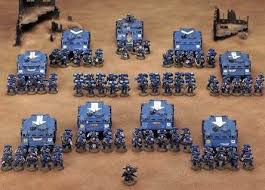
No More Free Stuff
One of the biggest complaints about the Gladius Strike Force or War Convocation is the ability to access free points through free transports or free wargear/upgrades. I think that any formation that grants a player free points immediately puts their opponent at a disadvantage.
What is ridiculous is that the minimum buy-in for the dual Battle Demi-Company Gladius is only 985 pts; Captain, Chaplain, six 5-man tactical squads, two 5-man devastator squads, two attack bikes and three units of scouts. With this, a marine player can potentially access 280-440 pts of free transports.
Alternatively, one solution to this may be to change the minimum requirements for the Battle Demi-Company to access the free transports. Forcing players to take 10-man tactical, devastator and assault squads would increase the minimum buy-in for the dual Battle Demi-Company Gladius to around 1750 pts. This would still allow players to use the force in tournaments, but without any weapons upgrades, so the army may suffer.

Objective Secured
I wonder if making Objective Secured exclusively for the CAD would mitigate the value of formations in 40k. No access to Objective Secured or limited access to Objective Secured in formations might make players seriously consider whether to use the formations over the CAD.
As mentioned above, the lack of Objective Secured is a key factor in making it easier to beat the Necron Decurion. Would the dual Battle Demi-Company Gladius formation be as popular if the units lacked Objective Secured?
Certainly, some of the later marine formations have lacked objective secured or had limited access to it. The new White Scars formations have very limited access to objective secured. Only the Scouts in the Stormbringer Squadron have inherent access to the rule.
For me, Objective Secured is very important in an army, particularly in maelstrom missions. Forcing players to choose between fancy formation rules and objective secured in the CAD may cause them to take stock and decide which to use.

More Power!
Another issue with formations is when powerful formations are given to already powerful armies.
Coming off the 6th edition powerhouse codex of the Eldar, I think most players would agree that the Eldar 7th edition codex did not need a power boost. In a similar stream, Codex Space Marines has always been a strong codex, the addition of the Gladius made it even more powerful.
It would be nice to see future formations give nice, thematic bonuses to armies without being too powerful or auto-include. This itself creates a whole new can of worms; how powerful is too powerful? Who decides? When are Chaos Space Marines finally going to get some love? (Too soon?)
Pay for What you Get
It might be nice to go back to the original Apocalypse model where you had to pay an additional cost for your formation special rules. This may force players to decide whether the cost of the formation is worth the rules or would it be better spent on more toys?
The problem with this then becomes balancing how much each formation should cost and whether there is an inherent “tax” already associated with the unit requirements of the formation.
In Conclusion
I hope that you have enjoyed my thoughts on formations in 40k. What started as a small article, quickly ballooned into a treatise on the current state of army building in 40k with lots of my opinions. I think this was inevitable. Just check out any forum or site where formations and detachments are being discussed and you will find a lot of strong opinions going one way or the other.
So over to you dear reader. If you have made it this far, I am sure you have your own opinions on formations. Are you for or against them? Do they breathe fresh life into 40k or are they the bane of your existence? Are they too open to abuse? Comment below and let me know what you think.
And as always, Frontline Gaming sells Games Workshop product at up to 25% off of retail, every day!
You can also pick up some cheap models in our Second Hand Shop. Some of these gems are quite rare, sometimes they’re fully painted!

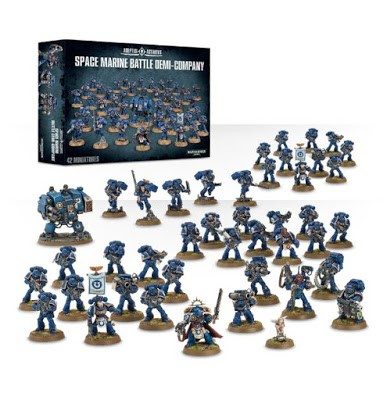
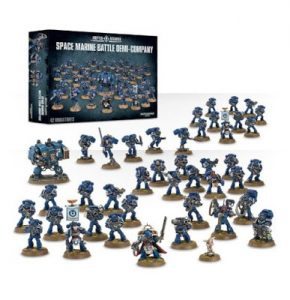
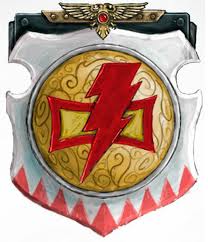
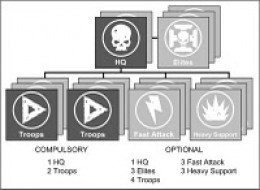
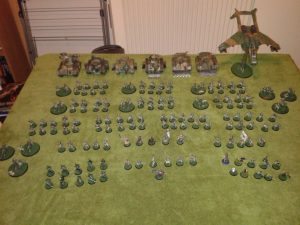
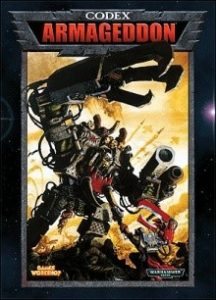
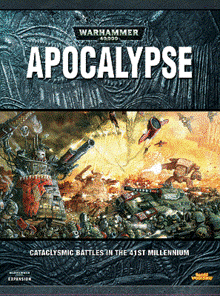
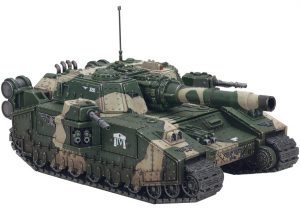

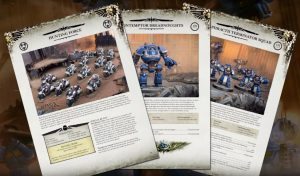
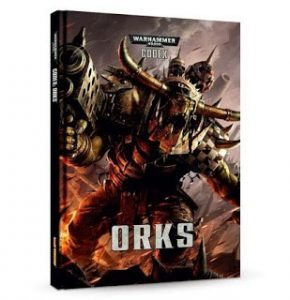
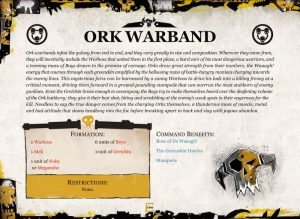
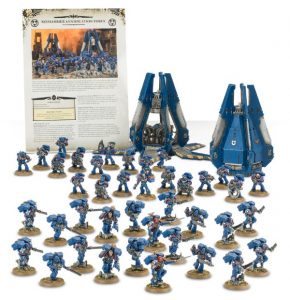
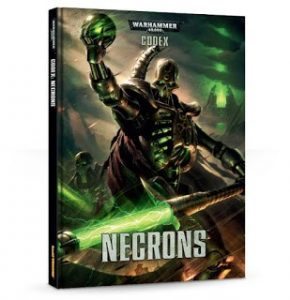
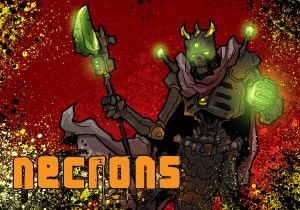

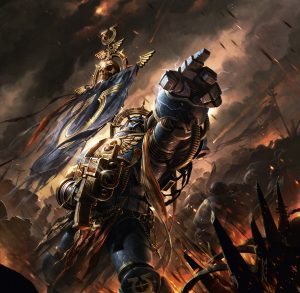


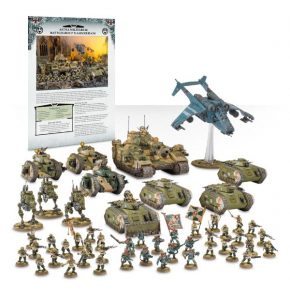
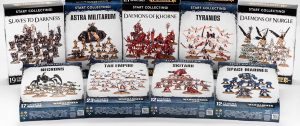

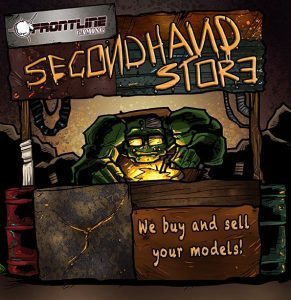
With all due respect… you say “I have never actually faced this type of army before, so don’t know how difficult it can be first hand. My only guide is from what others have told me about it and what I have read online” …. then go on to say how it’s broken and say there should be minimum buy ins, limits, etc.
So great suggestions like.. “increase the minimum buy-in for the dual Battle Demi-Company Gladius to around 1750 pts. This would still allow players to use the force in tournaments, but without any weapons upgrades, so the army may suffer” are based upon? Have you ever tried playing this force? Have you ever played against it? I encourage you do field research before stating an opinion.
I do agree that some things get out of whack and way to rock paper scissors with the current formation trend. Riptide Wing and, worse yet, Optimized Stealth Cadre (two formations you glossed over since your vast experience includes only have one of the kauyon books) are great examples of this. If your army happens to be one that can deal with it (ignores cover manticores vs OSC? ..yes please) then great. If not, well you’re in for a very tough match up.
You attack “free stuff”, yet the point is that every formation comes with free stuff, whether it be in the form of units, upgrades, or special rules. As pointed out, it all comes down to the tax. Ask any Space Marine player about about the just under 1k points does on the table vs the efficiency of an Eldar player running Aspect Host (or any player adding it to their army). The only tax in that formation is adding an Exarch? How do Mechanicus players feel about the points efficiency of their Rustalkers, Walkers, or Infiltrators? Given the opportunity, I bet many would switch them out.
I’m just saying that you should go out and get some table experience vs these armies before you holler for change. Just because the Internet told you they are broken doesn’t mean they are. Unfortunately, 40k has become a very Rock Paper Scissors environment of late. If your article addressed that primarily, I would be fine with it. Instead you poke at individual examples, which you state you have limited experience with, yet give a pass to the problems haven’t faced.
It is this type of “because someone told me so” logic that leads to bad decisions and bad feelings.
That’s a fair point. Many of my thoughts on the Battle Demi-Company came from speaking with other gamers at my club or online who play the formation or have played against it. I never said that the formation is broken, just that it is very strong, one of the strongest out there I think.
Free stuff in formations in the form of rules and bonuses is always going to be hard to quantify, the dual Battle Demi-Company and War Convocation bear the brunt of it as you can put actual values on what they get for free.
Of course, there are very strong formations outside the ones I have mentioned, many of which I have played against. I simply didn’t have time to include every strong formation in the game at the moment (there are so many) and the article was long enough as it was.
I think the complaining about free points in formations definitely has to do with the quantifying.
For instance, the ravenwing re-roll cover saves and stealth, that increases the durability of bikes to shooting by 450% (re-roll 3s instead of just 4s, so 1/9 compared to 9/18). Correct me if this is wrong, I don’t own the book just going off of what you said.
What would you pay for that if you could just buy it? It would probably be an upgrade of something like 20 points per model. That battle company dark angels player who won, he had 10 bikes at least. So that’s 200 “Free” points but because people can’t agree on if its 200 or another value, its not brought into the discussion on free points. Okay, maybe it would actually be 150 extra points, or maybe 250. The exact number isn’t important.
Same for Necrons. What is a flat +1 to RP across most or all of your force worth in points?
That is a good point and it took me a while to see it. It still smells of an off way to sell models for me but otherwise free wargear is no real different from other bonuses.
Personally I’d like 8th edition to bring in a system similar to AoS matched play, where your army has over arching limitations and requirements that you must meet and formations are something you layer on top of that and cost points (though not a lot of points, 60 – 120). And you could also bring in the bonuses for building a themed faction orientated force.
I don’t know too much about the AoS system. I am loathe for them to start restricting too much, we all want to play with our toys, but some of the power levels and bonuses for the formations are very high.
In AoS you need at least one leader (HQ) and can have a maximum of 6, at least 3 Battleline (troops) units and then you can only have 4 monsters and 4 artillery units. Having an army that is entirely one faction unlocks more elite units as Battleline units.
Battalions (formations) cost points and are basically extra rules you buy for your army as long as you have the units or other battalions needed.
There’s then faction abilities if your army is all a specific faction or more general grand alliance abilities if you have units from different factions part of the four major alliances.
Basically it’s a much more simple and open but at the same time fair system. If you go faction specific and themed you can take elite units as troop and get abilities more useful to your faction. Or you can ally up and pick and choose units but that means getting less useful abilities and having to take more basic units as your troops. And of course you pay points for formations.
For the most part, formations are fun and interesting. Most are fair to middling in power level, some are strong but reasonable. A few are very powerful indeed.
I think I’ve come up with a simple and reasonable solution for curtailing the abuse (maybe too strong a word, overuse?) of the Librarius Conclave. As it stands, LibCon is the only way I’m aware of to include Librarians in a Space Marine Strike Force. While powerful, the inbuilt costs of a Strike Force plus LibCon make it harder to layer on other highly effective units or formations. The “abuse” comes from simply taking the LibCon formation and combining it with anything you want, often tacked on to a CAD and/or other free standing formation(s). Typically, a Deathstar of some kind.
The solution would be to move the Librarius Conclave from Auxiliary to Command. That way, LibCon could only be taken within a Strike Force, preventing it from being added as a free standing formation to anything willy nilly. These even makes sense game-wise since Librarians are HQs and Command is where the HQ units can be added. While powerful combinations can still be created, they will be somewhat reigned in by the costs of taking a Demi-Company (or its equivalent) and an Auxiliary before a Librarius Conclave can be added.
In regards to CAD and Allies, they can already add Librarians as individual HQs so they retain their ability to add psykers as needed. Just without the rather game changing bonuses of the Conclave.
This wouldn’t even require action from GW. Tournaments could simply add it to their list building restrictions (which pretty much every Tournament includes anyway).
Yeah, the Librarius Conclave is very powerful for Deathstar armies. That’s an interesting suggestion about changing its type to Command.
I would personally like to see either the removal of the shared powers or the bonuses to casting. Taking away one of these would greatly diminish the effectiveness of the Conclave (and other such formations that get bonuses to casting values).
I made an error in my post this morning. Librarius Conclave is already in Command but can still be selected as a free standing formation. So, I would like to modify the idea as such:
Librarius Conclave cannot be taken as a free standing formation, it can only be selected as a Command slot within a Strike Force.
This would curb the Deathstars somewhat (after all, they can still take Librarians as HQs but they wouldn’t be as efficient at casting powers) but still leave it as an option for the more points intensive Strike Force.
Command formations can be taken in their own right just like any other formation.
Also, it is already a command choice, not am auxiliary.
Dang, you’re right. My apologies!
In my defense, the way they were showing up all over the place, I just figured they were an auxiliary anyone could take.
Still, I think the premise is worth considering: Librarius Conclave could be limited to only being an option within a Strike Force. That would prevent them from being easily slotted into a Deathstar.
Lot of people don’t know this, but there is a Wolfbrarius Wolfclave.
It’s not nearly as powerful, but you can make a quite capable deathstar using only Space Wolf stuff.
But with the wolfbrarius the wolfstar can’t wulfen-run out of combat to wolf the charge wolfs every turn. wolf
As long as a formation has an entry, it can be taken on its own – regardless of whether it is command or auxiliary.
Another example is in the new Daemonic Incursion for Daemons. The “Infernal Tetrad” is a 4 Daemon Prince formation that is a command formation. But it has its own dataslate and, therefore, is able to be taken in any army whatsoever. On the other hand, there is a Daemon Lords command option (don’t remember if that’s the exact name) but that one is not actually a formation. It’s just a command choice that allows you to take a single Greater Daemon as an add-on. Because it doesn’t have a formation dataslate, you can’t use it to just add a Greater Daemon to any army.
You are quite correct, my mistake was in making assumptions based on how it was being used without verifying in a codex. Shows how often I’ve used LibCon (never so far).
So, in order for my idea to work, the Tournament Organizer would state that the Librarius Conclave could only be selected as a Command slot within a Strike Force.
On a side note, I’m not saying every TO should do this. This is just a suggestion for how a TO could curb LibCon without having to actually change it.
I wish GW would be a little more consistent not only in the power of certain formations, but also in the buy-in. I’ve got a pretty decent-sized Daemon army (haven’t added it up in a while but I’d guess around 6k or more) and I can field almost none of the formations in that book. In an environment where most of my local tournaments are around 1500 (sometimes as low as 1k or as high as 2k), if I tried to field any of the core choices in the daemonic incursion they would be my entire army. Not only that, but they give a very small list of “here are 2 or 3 units you have to spam 6-9 times in order to field the formation.” Don’t get me wrong, the bonuses for the DI are very strong but spamming upwards of 1k points of the exact same unit does not make for the most enjoyable composition when a lot of the other Decurion-style core formations consist of maybe 500-700 points and actually have some different units even within that core formation.
Yeah, some armies suffer more than others. The Ork and Astra Militarum “Decurions” have a big buy in for just the core units. It’s ironic that the ‘cheaper’ armies have to take much more in these types of formations.
One important thing to note about the Ork Waaaagh Band is the nerf on the mob rule table. It isn’t very good because the penalties to mob rule are generally going to be worse than the bonuses for that formation (And most other Ork Formations). In 95% of games you will do better taking the exact same units from a CAD rather than using a Waaaaagh Band. I contend this is a typo, and was meant to be a buff to mobrule rather than a nerf, because the fluff on it implies that the Orks are more disciplined, but in the Ork FAQ GW didn’t fix the typo, so maybe it was intention that this formation would be less powerful than the same modes in a CAD.
An Ork Formation that gave every unit feel no pain would be something like this:
Painmob:
1 Painboy or Mad Dok
3 Units of Boyz
1 Unit of Nobz or Meganobs.
Share the Pain: So Long as the painboy is alive all models taken as part of this formation gain the Feel No Pain special rule.
Formations are a big problem for the current 40K meta. They do some very, very bad things.
1) They raise the barrier for entry to play. As you said in your article, you don’t have the models to field most of the formations. It requires you to expand your 40K collection to be able to play the same sort of game you used to.
2) They increase imbalance. Some armies have super powered formations (Eldar, Tau, Space Marines, Necrons). Some have really unweildy or weak formations (Orks, Tyranids, IG). Wait…. Aren’t those weak formation armies also the armies with weaker codexes to begin with? Yes. Yes they are. It changes them from underpowered to unable to effectively compete.
3) They complicate the game. Alot. By stacking special rules on top of special rules you open the game up to a ton more misplays, and list building errors. You also make it increasingly hard to finish games in the allotted time. We’ve seen a similar rise in DQ’s, and cheating allegations, not to mention the dozens of games where someone just accidentally plays the formation rules wrong, and you don’t realize it until you look it up after the event. It is a mess.
4) They drastically reduce army diversity. This is linked to the imbalance, but also due to meta shifts that are forced by a proliferation of Spam (Warp Spiders, Riptides, Rhinos/Razorbacks).
It’s time we reorganize the meta. Splitting the competitive format to a no formation 1500 point version, and a 2500 point formations allowed.
As mentioned by BigPig 40K is increasingly Rock-Paper-Scissors. That is not a good state for competitive 40K, and it is time we take a serious look at it. Nearly everyone is unhappy with the current state of army comp, and most people want more restrictive list building guidelines.
I remember then formations came out and I thought that this would be cool ’cause we’d finally use some untis you never saw otherwise. And then they just made them so they’d buff Warp Spiders…
Yeah, I liked formations when they first came out and it was like “cool, we get some nice, fluffy formations for fielding thematic units and it buffs them a little bit so you aren’t hamstrung by taking a themed list.”
Then it devolved into “do you just want a straight up buff to spamming an already good unit like Warp Spiders? Then this formation is for you.”
You guys are 100% right. It is a failure of design philosophy that is primarily the result of rapidly changing philosophies.
Tyranids, Dark Eldar -> Lets add incentives to take units that aren’t very good.
Orks, IG -> Let’s make formations neutral by including buff and nerfs with each one so that you aren’t netting out much of a power increase.
Cult Mech / Space Marines -> Points don’t matter. Sigmar is going to be huge!!! Free Stuff for everyone!
Eldar, Tau -> Let’s add incentives to spam the most popular units with big buffs and no taxes.
You could even get much more refined, but the key element is a lack of consistency in the design philosophy made them a huge problem for the meta, and one that we should address.
“ult Mech / Space Marines -> Points don’t matter. Sigmar is going to be huge!!! Free Stuff for everyone!”
…
I think I love you…
Don’t forget “CSM -> Haaaaa. You guys thought you’d get real formations. Have some Possessed with that whine.”
They did give ’em the Cabal.
Granted between the cabal, forsworn knights, and air superiority detachments of helldrakes there’s basically no reason to field an actual CSM army, and the faction now consists almost entirely of sorcerors, mechadragons, and bulletspam knights.
I understand you’re just trying to illustrate a point with the whole battle company example but I have 2 problems with it:
1. The changes you suggested would kill battle company outright, taking a 10 man dev squad and a ten man assault squad is would nuke the point efficiency of the company right back down to normal cad level. A ten man assault squad in tounament play cost 140 points and is worth probably 30. I would trade the whole unit for a grav cannon or a rhino any day. The extra 5 devs are worthless. I would trade all of them for an auspex or melta bomb most of the time. The reason battle company works is that the free transports make the army point efficient enough to stand up to eldar and necrons. Now, to be fair it is a bit too strong, a 10-15% nerf would make it less ubiqutious but what you’re suggesting would make it pointless.
2. EVERY FORMATION GIVES FREE POINTS! Just because the points come in the form of rules rather than models does not make them any less free. You think a thunderwolf costs 30 points more to put a character on than a bike because wolves look cool? No it’s the extra attack, +1S and rending that make it 30 pts more. Rules have value that is usually reflected in points. Formations as they exist now need to be looked at because they all have the same cost (0) and there is wild variation on quality. Just everyone stop whining about free points like a rhino is better than +1 ballistic skill on warp spiders or turn 1 no scatter deepstrike charges.
While there are a few formations that I think add to the game and allow you to run pretty cool things you otherwise probably wouldn’t (Emperor’s Fist Armoured Company is a favourite of mine, Corpsethief Claw, Bully Boyz, 1st Company Strike Force), there are too many that make the game an unenjoyable experience for me. I played against Tetrad at the weekend, pre-arranged with my opponent so I brought Battle Company, and I managed to *just* win one of the three games because he rolled double 1s on Warp Storm then double 6s on his Khorne Prince on turn 2. Afterwards, we agreed that he wouldn’t run Tetrad and I wouldn’t run Librarius unless agreed beforehand, and moved on to play our first few games of 30k. And it was a blast! I ran Terror Assault, one guy ran Black Reaving, and the other ran an Onslaught detachment of Imperial Fists. 30k seemed to be 40k done right – very, very heavily restricted Psychic Powers (you can bring one Mastery 2 Librarian, basically), Rites of War adding character and opening up certain army builds without being overpowered or imbalanced against one another, no obvious ‘this is the greatest unit ever’ (between having to bring a guy for Master of the Legion, the ‘Support Officer’ restriction and the restrictions of your chosen Rite, we found there was no ‘Librarius + Thunderwolf Battle Leaders + Black Knights’ obvious bullshit option). I don’t know if it’s a by-product of every army being a set of optional rules laid over a stock army list used by everyone (though that certainly helps), but 30k’s myriad of limiting special rules and unlocks combined with Rites of War makes it a far more balanced and *interesting* game to build lists for and play.
I’ve heard many people extol the virtues of 30K for balanced gameplay. I have just got round to picking up a Betrayal at Calth box and intend to give it a go to see what everyone is raving about.
If 5e taught us anything, it’s that 40k can be a balanced game as long as it contains only marines and metal boxes containing marines.
Yep. I always smirk when I see people say “play 30k, it’s way more balanced.”
Of course it’s way more balanced – the armies are basically identical. If everybody just played Eldar, 40k would be perfectly balanced, too…
One one hand, I like most of the metaformations. The Decurion, the Gladius, even the Warhost when it’s not used to create Eldar biker gangs, all reward you for taking a characterful force. They incentivize army design that hews closer to the imagery and flavor of 40k, and give you a good reason not to take 2x min troops and then load up on firepower.
GW screwed the pooch with Orks and IG though, although Orks’ issue is compounded by hordes of light infantry that specialize in punching infantry to death just aren’t as good a core as they once were.
I’d argue the big issue is the plug-and-play formations like Riptide Wings and Aspect Hosts that let you staple multiples of an already powerful unit to any faction, tax-free. Those slowly push the game towards Unbound “just take whatever you want and call it an army.”
Definitely agreed on the last part. Formations by themselves aren’t bad, and are nice for getting more slots than a single CAD can provide. But when they take a strong unit and let you stick it anywhere then it gets ridiculous.
Funnily enough, you actually almost never see eldar biker gangs with the warhost. The detachment benefits don’t benefit scatbikes at all.
Formations are pretty cool, especially with some Codices having so many units that just suck arse on the table (Chaos Marines are my personal example of experience). So here’s to hoping Obliterators get a Formation someday soon so I can just all 11 of my old versions in one army! Iron Warriors should get those as Troops though darn it
For one, I don’t believe anyone has mentioned the fact that a gladius/battle company formation grants combat doctrines. If the battle company did not have these re-rolls, would it be as “top tier”? I think with ObSec and free transports a battle company is still good. But when all the grav and melta is not twin linked it changes the battle company from being a “top tier” army to good and in the right hands a still top tier formation.
Granted it is the main “Selling point” when one thinks about whether to make the investment, in $$$ and points, in a formation are the re-rolls or the dice efficiency of the formation, tacking on some some special rules or free upgrades generally pale in comparison to things like combat doctrines or re-roll cover saves (ravenwing strikeforce)
And thats where the difference in the strong formations vs the weak ones and codexes comes from. Already good codexes, Eldar Tau Space Marines, have access to formations which provide not only good bonuses but special rules which provide an abundance of re-rolls that other armies simply don’t have access to.
Great point! Anything granting re-rolls to slightly curb the randomness of the game is going to be a great boost to any army.
I have real problems with formations for a reason not mentioned in the article, mainly that theyre spread over several different sources.
I have no idea what is available to my army anymore because I dont own every single piece of source material, and dont even know which books contain what.
The GW website needs a repository with army headings, and a list of the formations available for them and the source book for that entry. You dont need to give the rules away for free, but atleast let me know its available and how to find it.